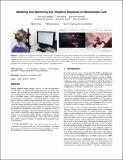Modeling and optimizing eye vergence response to stereoscopic cuts
Author(s)
Templin, Krzysztof; Didyk, Piotr; Myszkowski, Karol; Hefeeda, Mohamed M.; Seidel, Hans-Peter; Matusik, Wojciech; ... Show more Show less
DownloadMatusik_Modeling and.pdf (14.32Mb)
OPEN_ACCESS_POLICY
Open Access Policy
Creative Commons Attribution-Noncommercial-Share Alike
Terms of use
Metadata
Show full item recordAbstract
Sudden temporal depth changes, such as cuts that are introduced by video edits, can significantly degrade the quality of stereoscopic content. Since usually not encountered in the real world, they are very challenging for the audience. This is because the eye vergence has to constantly adapt to new disparities in spite of conflicting accommodation requirements. Such rapid disparity changes may lead to confusion, reduced understanding of the scene, and overall attractiveness of the content. In most cases the problem cannot be solved by simply matching the depth around the transition, as this would require flattening the scene completely. To better understand this limitation of the human visual system, we conducted a series of eye-tracking experiments. The data obtained allowed us to derive and evaluate a model describing adaptation of vergence to disparity changes on a stereoscopic display. Besides computing user-specific models, we also estimated parameters of an average observer model. This enables a range of strategies for minimizing the adaptation time in the audience.
Date issued
2014-07Department
Massachusetts Institute of Technology. Computer Science and Artificial Intelligence Laboratory; Massachusetts Institute of Technology. Department of Electrical Engineering and Computer ScienceJournal
ACM Transactions on Graphics
Publisher
Association for Computing Machinery (ACM)
Citation
Krzysztof Templin, Piotr Didyk, Karol Myszkowski, Mohamed M. Hefeeda, Hans-Peter Seidel, and Wojciech Matusik. 2014. Modeling and optimizing eye vergence response to stereoscopic cuts. ACM Trans. Graph. 33, 4, Article 145 (July 2014), 8 pages.
Version: Author's final manuscript
ISSN
07300301